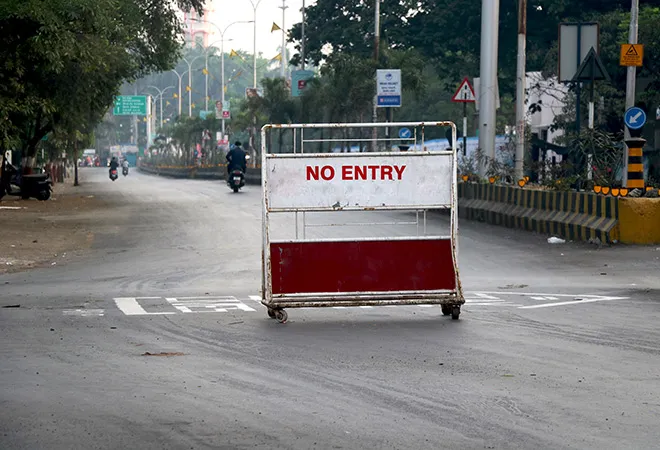
In order to curb the spread of the pandemic, on 24 March 2020, India announced a national lockdown that came into effect in a matter of four hours. States sealed their borders; transportation was scarce, educational institutions, offices and industries closed; only essential services were allowed to function. On hindsight one can say, the fallout of such a measure especially on the large population employed in the informal sector, the daily wage labourers and the migrant labourers in different states was not taken cognizance of. The impact on the economy and suffering of thousands became visible as the lockdown extended over two months. As restrictions are relaxed now under unlock 1.0, even as the number of people affected by COVID19 continues to rise, economic slowdown and nutrition insecurity stares us in the face.
Relief measures like distribution of free grains through the public distribution system (PDS) and pension payment to the aged in advance were announced; but given the lacunae in the delivery system, many are left outside the ambit of the PDS and other social safety nets. Migrant labourers in different parts of the country are one example. In terms of impact on different sectors, the rabi crop harvest period coincided with the lockdown, and the non-availability of labour and machinery, harvesting was a challenge. Restrictions on transportation led to disruption of the food supply chain. According to a study by Rawal et al. (2020), the number of mandis reporting market arrivals of wheat fell from 746 in the week ending March 22 to just 235 a week later. There was a demand-supply mismatch as produce could not reach the point of consumption. There have been reports of farmers dumping their produce on the roads for lack of transportation. The poultry and fishery sectors were similarly affected. The micro, small and medium enterprise (MSME) sector that is dominated by microenterprises in the informal sector, employs about 111 million people, and contributes to 29% of the country’s GDP, has also been badly affected. With no operations for two months and strapped for liquidity, many of them will simply disappear. A recent study reported that the incomes lost by vulnerable sections of India’s workforce during the two months of lockdown would amount to about Rs.4 trillion, or nearly 2% of the country’s annual GDP.
It is but natural that the nutrition status of our population will worsen further in the prevailing scenario. The Integrated Child Development Services (ICDS) and the Mid-Day Meal (MDM) Scheme are two major social protection programmes to address the food and nutrition needs of children; children between 3-6 years are provided meals at the ICDS/Anganwadi centre and 6-14 years get MDM at schools. Pregnant and lactating women and children between 0-2 years get take home ration (THR) from ICDS centres; in some states, women also get meals. With the closing of Anganwadi centres, while the government announced supply of THR through frontline workers, there was a shortage of manufacturing units that produced THR. Likewise, school children were to get grains or allowance in lieu of the MDM, but there were many slips in implementation, leaving large numbers deprived. The plight of migrant workers following the lockdown has been most heartrending. Left with no work and food, and no arrangement made to travel home, a large number were at a loose end, as reported widely in the media. Given that many of them were from different states, they did not have access to the PDS in the state where they worked. A survey covering 5162 households in 47 districts across 12 states, found that over 50% of households in rural India were having reduced number of meals, while about 68% had reduced the number of food items in the meal ever since the lockdown was imposed. The 5kilogram of additional grain and 1kilogram of pulses to be given in the PDS for three months announced as part of the relief package would possibly help some of the households but is not available for people without ration card. Procurement and distribution of pulses to even eligible households has also been fraught with problems and as of early May, not even a fifth had received the promised quota. Under the circumstances, we can expect protein energy malnutrition and micronutrient deficiency or hidden hunger to increase.
It is disheartening that a coordinated approach to take care of the poor and vulnerable has been missing on the ground. Simple measures like making the PDS universal during this period of crisis, as recommended by several noted economists, so that all needy people including migrant labourers would atleast get food grains, would have really helped. With 77 million tonnes of foodgrain stock in FCI godowns, and rabi procurement yet to happen, availability for this purpose was not an issue, but the intent was sadly missing. Cash transfers have been made but not to the extent desirable; a large majority of migrant labourers were left out. A decision to transfer Rs.7000/month for three months to all poor and migrant labour households as recommended by the Stranded Workers Action Network’s Report would have gone a long way in providing much needed aid. Measures like collateral free loans for MSMEs do not carry much weight as the loan will be granted only on fulfilling several assessment criteria like turnover and stocks that would have been affected following the lockdown. In fact, as pointed out by many, there isn’t much by way of additional spending to provide relief in the many measures announced by the government.
What are we going to see in the coming months? Expectedly, many of the migrants who manage to return home will not wish to return or atleast not immediately. Work under the MGNREGS has resumed and the government has announced an increased allocation over the budgeted amount in the current fiscal; the help of NGOs is being taken to make people aware and enroll all those willing to work under the scheme. But further allocation and widening the scope of the scheme itself to create more community assets is required. The government of Odisha for instance, has initiated measures like promoting household nutrition gardens of fruits and vegetables under MGNREGS. Community nutrition gardens on common land in villages managed by groups of women can also be made an approved activity. Decentralised approaches like linking farmers in a district with institutional feeding programmes in schools, ICDS centres, hospitals can be an incentive for farmers in terms of assured market and also ensuring regular supply to consumers. Panchayats should become more proactive; more of decentralized storage and processing facilities and strengthening of farmers’ collectives are also called for. The COVID19 threat continues and we are definitely going to slide further from reaching the SDG targets. This is also an opportunity to reflect and do things differently so that development is bottom-up and benefits are more equitably shared.
The views expressed above belong to the author(s). ORF research and analyses now available on Telegram! Click here to access our curated content — blogs, longforms and interviews.




 PREV
PREV



